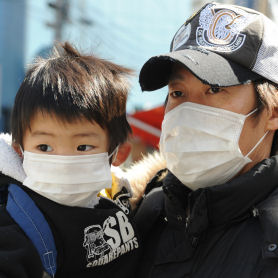Japan food fears as engineers battle to cool nuclear plant
Japan is considering banning the sale of food from Fukushima due to radiation. Teams are trying to restore power to the nuclear plant and Alex Thomson says businesses are closing early to save energy.
Japan reported its first contamination of food since the powerful earthquake and tsunami that has left nearly 18,000 people dead or missing.
The country is considering a halt to all food product sales from Fukushima prefecture, said the International Atomic Energy Agency (IAEA) which warned that radioactive iodine found in food can pose a short-term risk to human health.
Radiation levels in milk from a Fukushima farm about 30 km (18 miles) from the plant, and spinach grown in Ibaraki, a neighbouring prefecture, exceeded government limits.
Faint radiation was also found in tap water in Maebashi, 100 km (62 miles) north of Tokyo, Kyodo News reported.
Chief Cabinet Secretary Yukio Edano told reporters before the IAEA warning that higher radiation levels posed no risk to human health, but the findings are sure to heighten scrutiny of Japanese food exports, especially in Asia, their biggest market.
Restaurants in Singapore are already considering importing sushi, sashimi and other Japanese ingredients from elsewhere.

Race to cool nuclear reactors
One of six tsunami-crippled nuclear reactors appeared to be stabilising as Japan attempts to restore power to the stricken plant.
Engineers reported some rare success after fire trucks sprayed water for about three hours on reactor No.3, widely considered the most dangerous at the ravaged Fukushima Daiichi nuclear complex because of its use of highly toxic plutonium.
“The situation there is stabilising somewhat,” Chief Cabinet Secretary Yukio Edano said.
Engineers earlier attached a power cable to the outside of the mangled plant in a desperate attempt to get water pumps going that would cool overheating fuel rods and prevent a deadly radiation leak.
They hope electricity will flow by Sunday to four reactors in the complex about 240 km (150 miles) north of Tokyo.
Humanitarian effort
The operation to avert large-scale radiation has overshadowed the humanitarian crisis caused by the 9.0-magnitude quake and 10-metre (33-foot) tsunami.
Channel 4 News Chief Correspondent Alex Thomson is in Iwate Prefecture which has been devastated by the tsunami.
He tweeted that restaurants and cafes were closing early on Saturday to save energy: “Incredible – asked to help by saving power – half Morioka is shut. Streets empty. Shops shut. All voluntary.”
Some 390,000 people, many elderly, are homeless, living in shelters in near-freezing temperatures in northeastern coastal areas.
I’m leaving because my parents are terrified. Luke Ridley
Food, water, medicine and heating fuel are in short supply and a Worm Moon, when the full moon is closest to Earth, could bring floods to devastated areas.
“Everything is gone, including money,” said Tsukasa Sato, a 74-year-old barber with a heart condition, as he warmed his hands in front of a stove at a shelter for the homeless.
Health officials and the U.N. atomic watchdog have said radiation levels in the capital Tokyo were not harmful. But the city has seen an exodus of tourists, expatriates and many Japanese, who fear a blast of radioactive material.
“I’m leaving because my parents are terrified. I personally think this will turn out to be the biggest paper tiger the world has ever seen,” said Luke Ridley, 23, from London as he sat at Narita international airport using his laptop.
Officials asked people in the 20 km “take cover” zone to follow some directives when going outside: Drive, don’t walk. Wear a mask. Wear long sleeves. Don’t go out in the rain.
Though there has been alarm around the world, experts say dangerous levels of radiation are unlikely to spread to other nations.
The U.S. government said “minuscule” amounts of radiation were detected in California consistent with a release from Japan’s damaged facility, but there were no levels of concern.